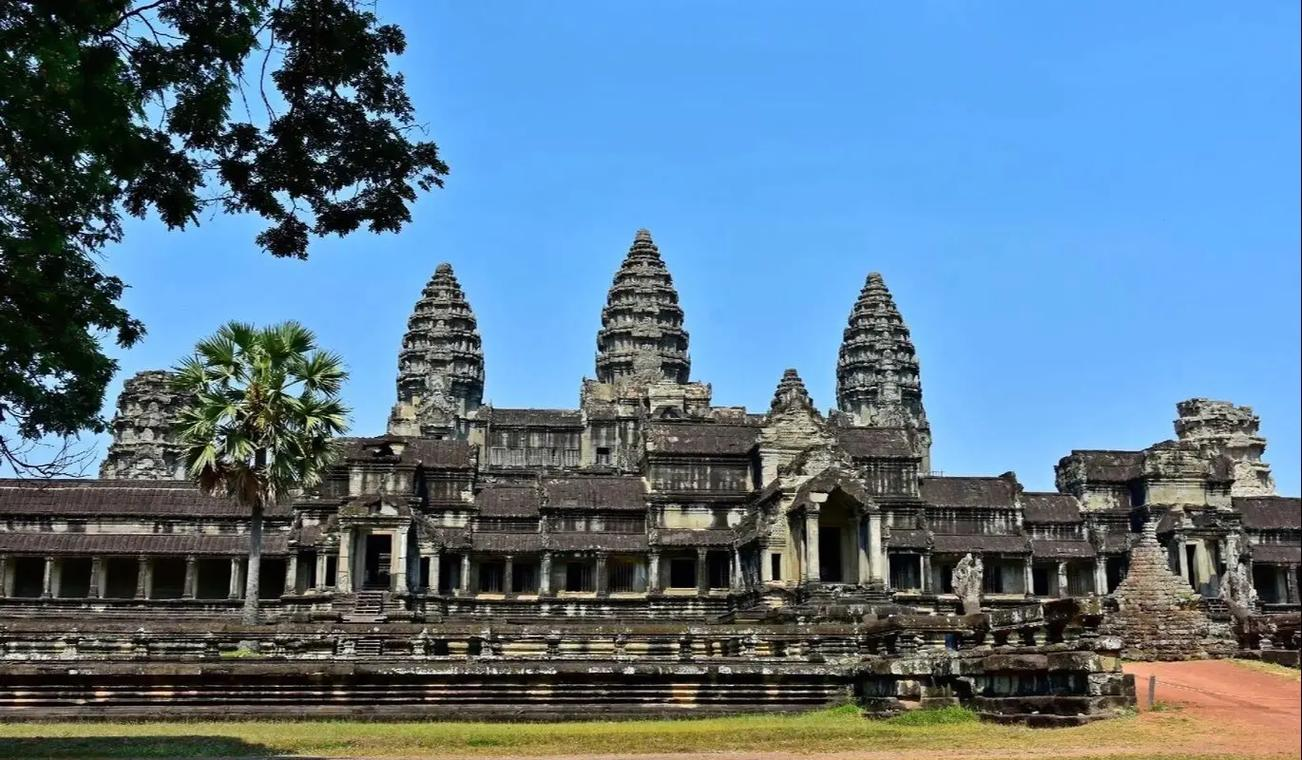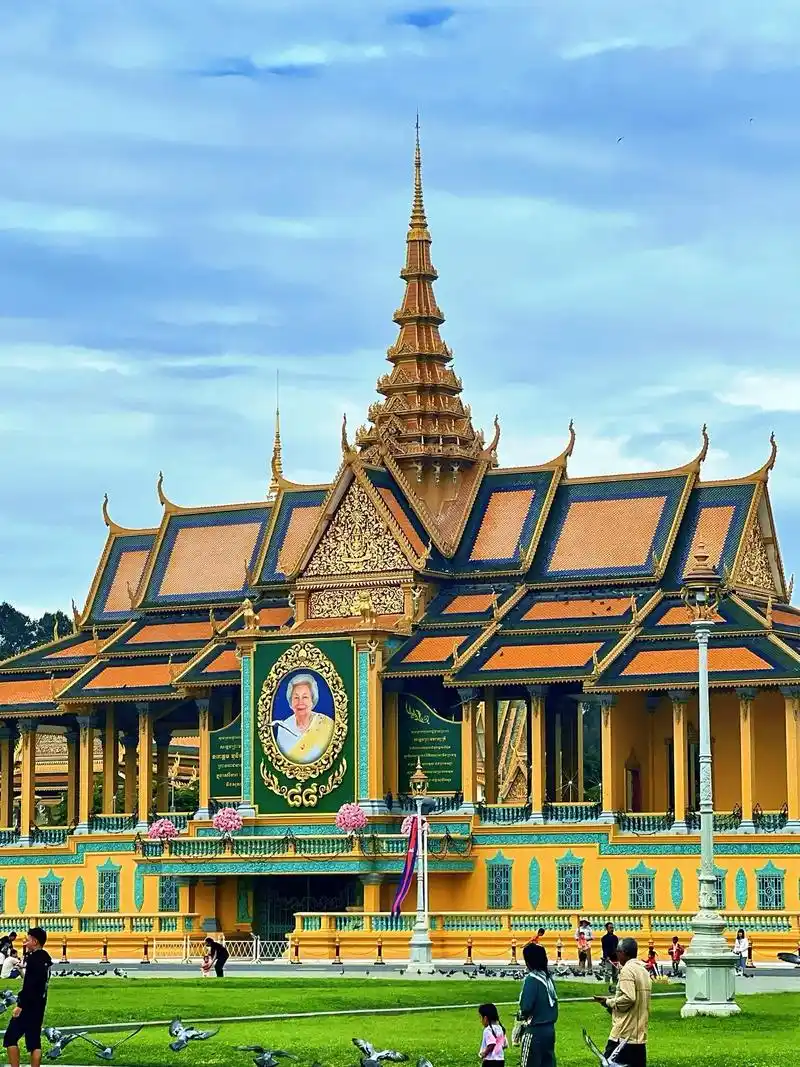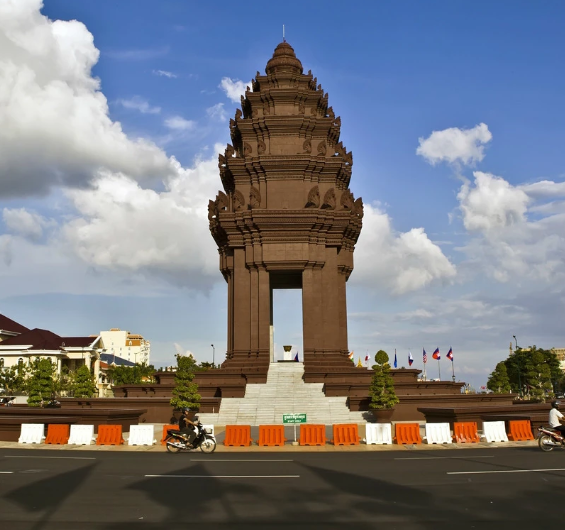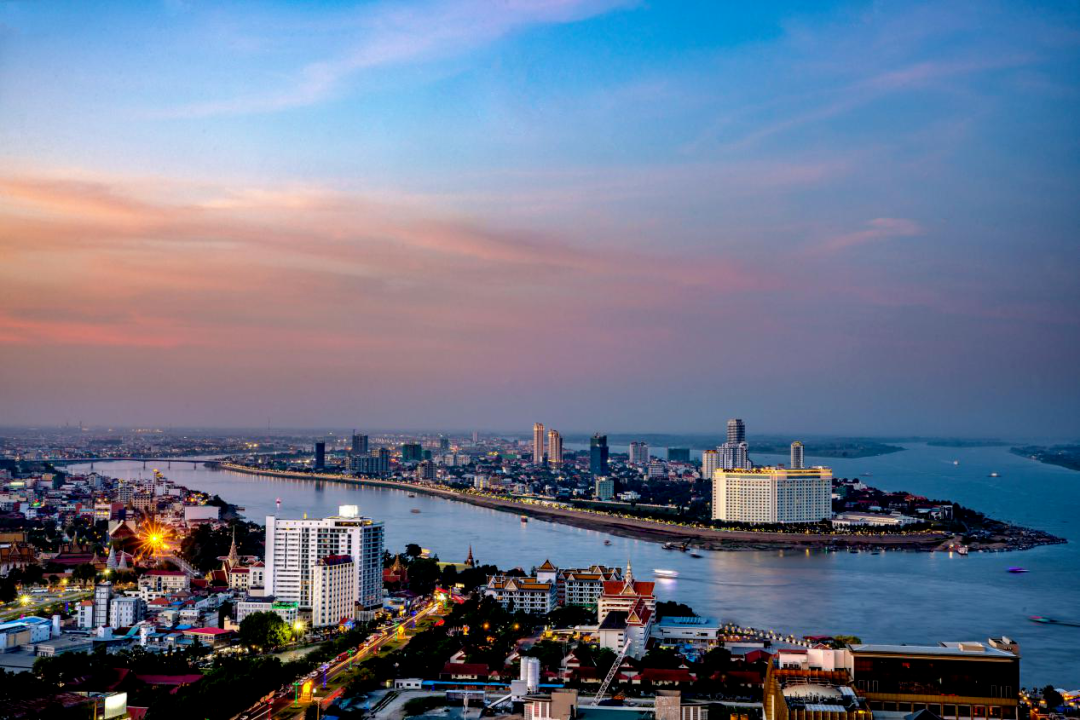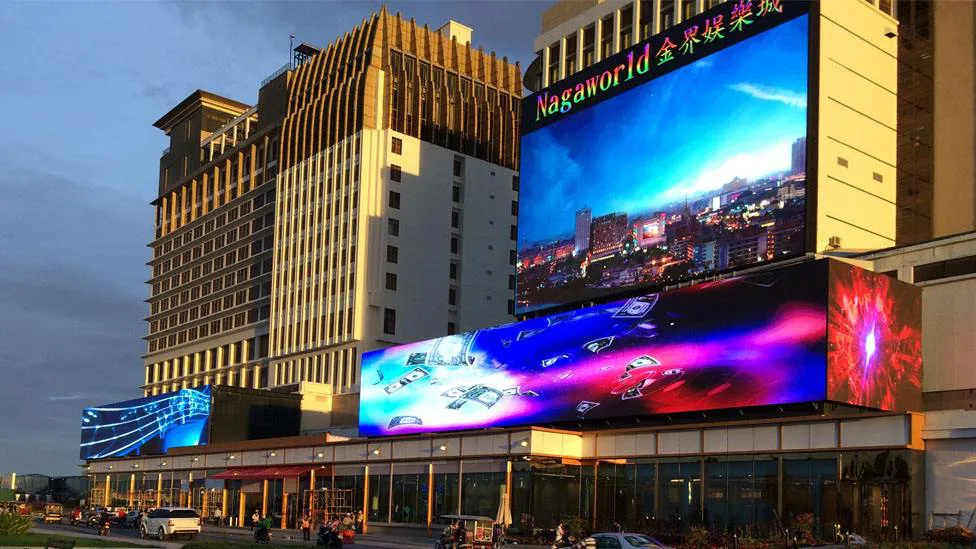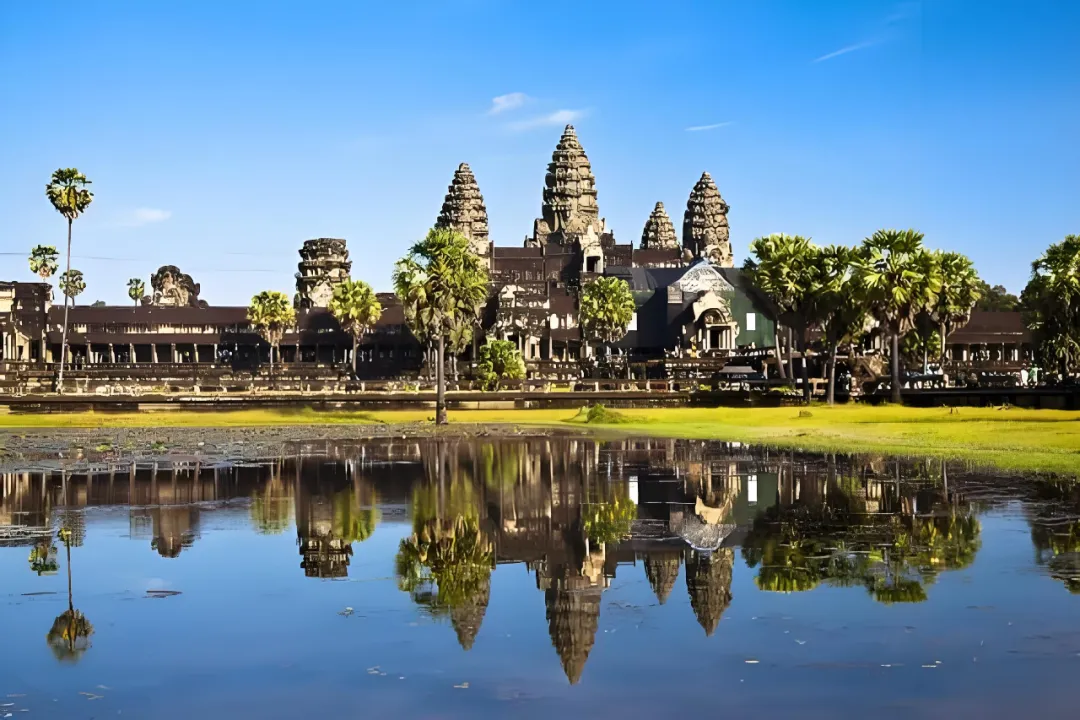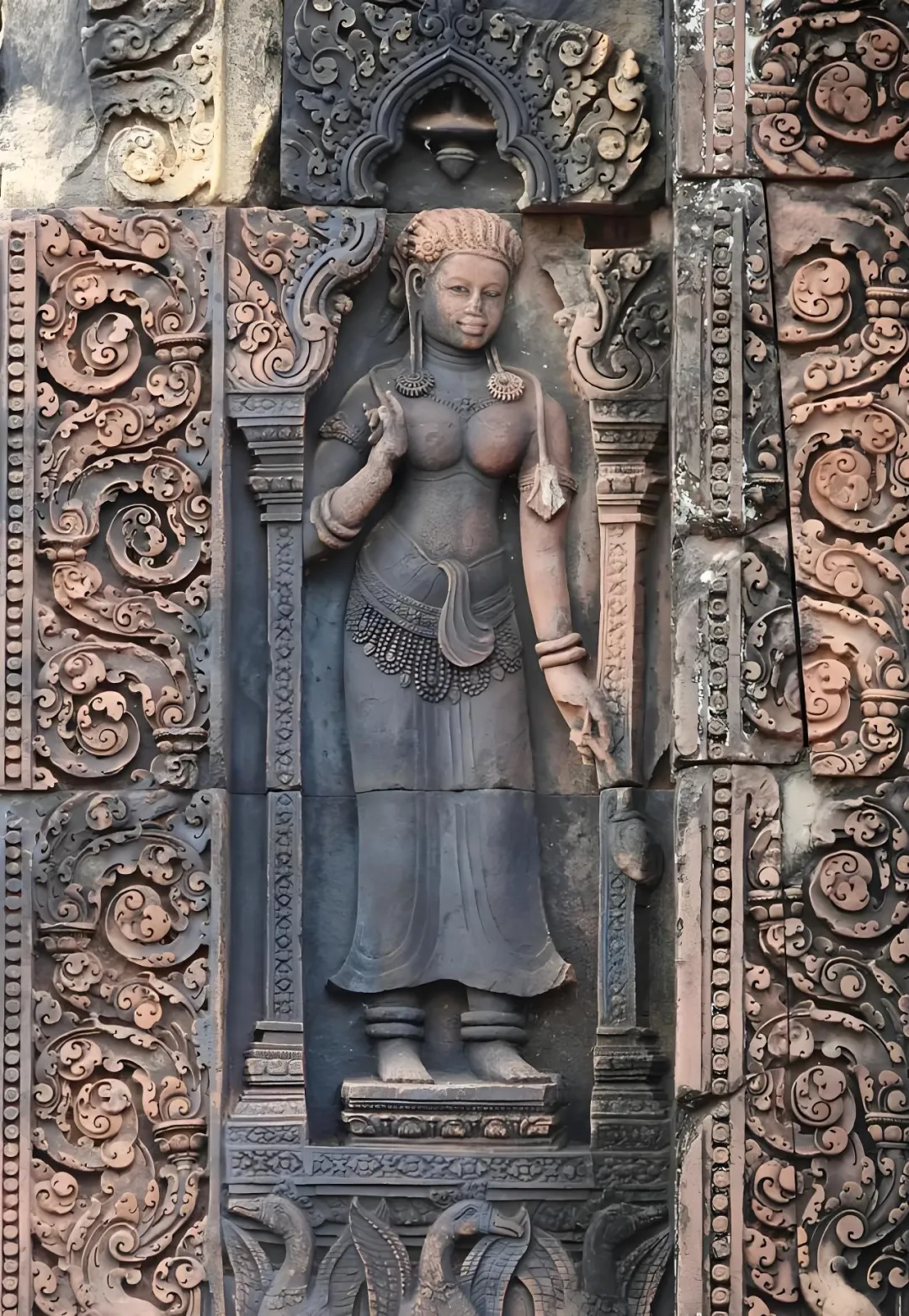Cambodia Overview
Cambodia, full name: the Kingdom of Cambodia[1], located in the Indochina Peninsula, bordering Thailand in the west and northwest, bordering Laos in the northeast, bordering Vietnam in the east and southeast, and facing the Gulf of Thailand in the south (formerly known as the Gulf of Siam)[2]. Cambodia's territory is a dish-shaped basin, surrounded by hills and mountains on three sides. The central part is a vast and rich plain, accounting for more than three-quarters of the country's area. There are the Mekong River and the largest freshwater lake in Southeast Asia - Tonle Sap Lake (also known as Phnom Penh Lake), the capital Phnom Penh. Cambodia's population is about 16 million, the Khmer population accounts for 80% of the total population, and the Chinese and overseas Chinese are about 1.1 million. The official language is Cambodian (also known as Khmer)[3]。
Cambodia is an ancient civilization with a long history, a unified kingdom was established as early as the 1st century AD. Starting from the 1970s, Cambodia experienced a long war. In 1993, with the successive establishment of Cambodia's state authority and the realization of national reconciliation, Cambodia entered a new era of peace and development.
Cambodia is a member of the Association of Southeast Asian Nations, the economy is mainly agriculture and the industrial foundation is weak. On July 1, 2016, the World Bank announced that Cambodia has officially separated from the least developed country and has become a lower-middle-income country.[4]。
Basic information
Chinese nameKingdom of Cambodia[1]
National LeaderKing: Norodom Sihamoni, Prime Minister: Hommane[5]
Foreign language nameKingdom of Cambodia
Land area181,035 square kilometers
AbbreviationCambodia
Expand
History
Cambodia was founded in the second half of the 1st century AD and went through the periods of Funan, Zhenla, Angkor, etc. The Angkor dynasty was at its peak in the 9th and 14th centuries, with a strong national strength and a developed culture, creating the world-famous Angkor civilization. It declined from the mid-13th century to 1434 due to the invasion of the Sukhothai dynasty in Thailand.
In 1863, it became a French protector. It was occupied by Japan in 1940. After Japan surrendered in 1945, it was once again occupied by French colonists.
On November 9, 1953, the Kingdom of Cambodia declared independence. In July 1954, France was forced to agree to withdraw its troops.
On March 18, 1970, Ronno launched a coup under the instigation of the United States. On the 23rd, Prince Sihanouk announced the establishment of the Cambodian National Unity Front, and on May 5, the Cambodian National Unity Government with Prince Binnu as the Prime Minister, and the Cambodian Communist leader Josen Pan served as deputy prime minister.
On April 17, 1975, the whole country was liberated. Between 1975 and 1979, the Khmer Rouge won the ruling power of Cambodia. In January 1976, a new constitution was promulgated and renamed Democratic Cambodia. In April, Prince Sihanouk and Prince Binu announced their retirement. Josen Pan served as chairman of the Presidium, and Pol Pot, General Secretary of the Communist Party of Cambodia (Khmer Rouge), served as prime minister. During the Khmer Rouge rule, as many as 2 million people died or were executed due to hunger, overwork, or torture.[7]。
At the end of 1978, Vietnam sent troops to invade Cambodia and supported the regime of the People's Republic of Cambodia. In December 1979, the Democratic Republic of China decided to terminate the constitution and reorganize the government. On July 9, 1982, the three resistance forces of Prince Sihanouk, Song Shuang and Qiao Senpan achieved unity and formed a democratic Cambodian coalition government. In September 1990, the three parties of the Cambodian Resistance Force and the representatives of Phnom Penh announced the formation of the National Supreme Council of Cambodia after meeting in Jakarta.
In July 1991, Sihanouk was elected as Chairman of the National Supreme Council of Cambodia. On October 23, the International Conference on Cambodia was held in Paris and signed the "Agreement on Comprehensive Political Resolution of the Cambodian Conflict" (commonly known as the "Paris Agreement". In November, Prince Sihanouk returned to the motherland and the Supreme Council of the National Establishment established its headquarters in Phnom Penh. From May 23 to 28, 1993, Cambodia held a general election under the organization and supervision of the United Nations Interim Authority in Cambodia, and elected a Constitutional Conference. September 21. The Constitutional Assembly passed a new constitution and decided to restore the constitutional monarchy. On September 24, Prince Sihanouk signed a new constitution, and the Constitutional Assembly was converted into the National Assembly. On September 26, the United Cambodia agency announced the end of its mission in Cambodia. On November 2, the Cambodian Kingdom Government was officially established. On November 15, all UN peacekeeping forces in Cambodia evacuated, and the Cambodia Kingdom entered a new era of peaceful reconstruction.

Cambodia
In May 1993, Cambodia held its first national election under the auspices of the United Nations. In September, a new constitution was promulgated, changing the country's name to the Kingdom of Cambodia, and Sihanouk became the throne again. In November, the Cambodian Kingdom government was established, with Lanaree and Hun Sen as the first and second prime ministers respectively. In 1994, the Cambodian Congress passed legislation to declare the CPPCC an illegal organization. In July 1997, military conflict broke out between the joint ruling People's Party (hereinafter referred to as the "People's Party") and the Fengsinbik Party (hereinafter referred to as the "Fengs Party"), and Lanarey was deposed as the first prime minister and went into exile abroad. On July 26, 1998, Cambodia held its second national election. The People's Party won and became the largest party. On November 30, the second coalition government with Hun Sen as prime minister was established. The Party Congress ranked second, and Lanarey became the president of the parliament. In December, former leaders of the Cambodian Cambodian Cambodian and Nong Xie surrendered to the government, and Cambodian national reconciliation made significant progress and entered a new era of peace and development.
In July 2003, Cambodia held the third national election and the People's Party won. The three parties, Renminbi, Feng and Sen have serious differences in the distribution of rights, and the formation of the cabinet is in a deadlock. On July 15, 2004, the deadlock in the formation of the cabinet was broken. The People's Party and the Feng Party reached an agreement on joint governance. Ranaree and Hun Sen served as president of the parliament and prime minister of the government respectively. The third royal government was officially established.
On October 6, 2004, King Sihanouk announced his abdication in Beijing. On the 14th, nine members of the Cambodian Throne Committee unanimously elected Sihamoni as the new king. On the 29th, Sihamoni ascended the throne at the palace.
Administrative division
Cambodia is divided into 20 provinces and 4 municipalities directly under the central government (the capital is in brackets): Bantei Mianji Province (Shishufeng), Battambang Province (Battambang), Kampang Cham Province (Kampang Cham), Kampang Qingyang Province (Kampang Qing Yang), Kampang Spei Province (Kampang Spei), Kampang Tong Province (Kampang Tong), Kampang Province (Kampang Tung), Kampang Province (Kampang), Kampang Province (Dakmao), Gogong Province (God), Baima City (Municipal), Kejing Province (Jijing), Mondokiri Province (Senmonolon), Odo Mianji Province (Songlang), Bailin (Municipal), Phnom Penh (Municipal), Sihanoukville Province (Municipal), Parveyah Province (Batha), Bosa (Batha), Bosa (Boratha), Bosa (Boratha), Bosa (Batha), Latanakiri Province (Banlung), Siem Reap Province (Sean Ding), Swai Rieng Province (Sain Rim), Tea Gum Province (Tea Gum)[8]。
capital
The capital Phnom Penh has an area of 376 square kilometers and a population of about 1.5 million (2013). Phnom Penh is located at the intersection of Tonle Sa River and Mekong River, and is the political, economic, cultural and religious center of Cambodia.
Natural environment
Regional location

Cambodia administrative divisions
Cambodia is located in the southwest of the Indochina Peninsula, covering an area of 181,035 square kilometers, and 20% is agricultural land. The southernmost to the west of the country is located in a tropical area, bordering Thailand's Koh Rat in the north by the Bob Pot Mountains, and the Latana Kiri Terrace and Chhlong Highland in the east are adjacent to Vietnam's central highland. To the west is the narrow coastal plain: the Sihanoukville Sea facing the Gulf of Siam. The Bob Pot Mountains are located north of the Tonle Sa River Basin and are composed of steep cliffs in the southern part of the Koh Rat Terrace in Thailand. They are the border between Thailand and Cambodia.
Topography
Central and southern Cambodia are plains, and the east, north and west are surrounded by mountains and plateaus, and most of the areas are covered by forests. The Ora Mountain in the eastern section of the Cardamom Mountains is 1,813 meters above sea level, making it the highest peak in the territory.
Climate characteristics
Cambodia has a tropical monsoon climate, with an annual average temperature of 29-30℃, a rainy season from May-October, and a dry season from November to April of the following year. Due to the influence of terrain and monsoon, precipitation varies greatly in different places. The southern end of Xiangshan can reach 5,400 mm, and about 1,000 mm east of Phnom Penh.
Water system distribution
The Mekong River is about 500 kilometers long in the territory and runs through the east. Tonle Sap Lake is the largest lake in the Indochina Peninsula. It has an area of more than 2,500 square kilometers at low water levels, and the lake surface reaches 10,000 square kilometers during rainy season. There are many coastal islands, mainly Gegong Island, Long Island, etc.
Natural Resources

Cambodia
Cambodia's minerals mainly include gold, phosphate, gems and oil, as well as a small amount of iron and coal. Forestry, fishery and fruit trees are abundant. It produces precious tropical trees such as teak, iron wood, red sandalwood, ebony, and white Mao, and has a variety of bamboo species. The forest coverage rate is 61.4%, mainly distributed in the mountainous areas in the east, north and west. The wood reserves are about 1.1 billion cubic meters. Tonle Sap Lake is the largest natural freshwater fishing ground in Southeast Asia and is known as the "fish lake". The southwest coast is also an important fishing ground, with many fish and shrimps. Aquatic resources are decreasing[1]。
National symbol
National flag
The Cambodian national flag is mainly red, blue and white. The white hall in the middle is Angkor Wat, surrounded by red and blue stripes (line ratio 1:2:1). Red represents the nation, white represents Buddhism, and blue symbolizes the royal family, which is in line with the national inscription of Cambodia. It was reused after the Cambodian campaign returned to the monarchy in 1993.
national emblem

Cambodia's national emblem
The pattern of the Cambodian national emblem is yellow Angkor Wat, with an octagonal windmill above it. A pattern with the king's sword as the center line symmetrical on both sides. The king's sword in the diamond pattern is held up by a tray, meaning that the king's power is supreme; on both sides are lions guarding the five layers of canopy, five symbolize perfection and auspiciousness in Cambodian customs; the palm leaves on both sides symbolize victory. The band at the bottom reads "King of the Kingdom of Cambodia." The whole pattern symbolizes that the Kingdom of Cambodia is a unified, complete, united and happy country under the leadership of the king.[9]。
National anthem
"Nokoreach" is the national anthem of the Kingdom of Cambodia. Its tune is adapted from Cambodian folk songs. The lyricist is the King of Monks. The national anthem was first adopted in 1941 and was re-recognized in 1947. At that time, Cambodia had just become independent from France. It was not until the royal family was abolished in 1970 that the national anthem was replaced. In 1975, when the Communist Party won, symbols of the former royal family, including "The Kingdom", were re-recognized for a short period of time. Later, the Khmer Rouge used "Glorious April 17" as its new national anthem. The status of the National Anthem of "King" was not restored until the royalist Party defeated the former Communist Party (Cambodia People's Party) in the 1993 general election.
Lyrics of "The Kingdom of Angkor":
God bless our king and gives him happiness and glory, and rule our souls and destiny.
The foundations of our ancestors have been passed down from generation to generation, leading the proud and ancient kingdom.
The temple is immersed in the forest and recalls the glory of the Angkor era. The Khmer nation is as strong and tenacious as a rock.
I believe that our kingdom has been tried and tested.
Melodious songs are delivered from the pagoda, dedicated to the glorious and sacred Buddhism, so that we can be loyal to the faith of my ancestors.
God is not stingy with his kindness and gives the ancient Khmer rivers and mountains[10]。
population
Cambodia's population is about 16 million[3]. There are more than 20 ethnic groups, among which the Khmer is the main ethnic group, accounting for 80% of the total population, as well as ethnic minorities such as the Champa, Punong, Lao, Thai and Stin. About 1.1 million Chinese and overseas Chinese, of which about 70% of them are Chaoshan, Guangdong.[2 items]。
politics
Political system

Cambodia
Implement a constitutional monarchy. The king is the supreme head of state, the congress is the supreme power and legislative body, and the Senate has the power to consider bills passed by Congress. The head of government is a party candidate who wins a 50%+1 simple majority. Current King Norodom Sihamoni, Senate Chairman Hun Sen[12], Congress President Han Sanglin, Prime Minister Hong Mane[2 items]。
constitution
The current Cambodia Constitution was adopted by the Constitutional Conference on September 21, 1993 and signed and entered into force by King Sihanouk on September 24 of the same year. The Constitution stipulates that Cambodia's state system is a constitutional monarchy, implementing a multi-party system and a free market economy, and the three powers of legislation, administration and judicial powers are separated. The king is a lifelong head of state, the supreme commander of the armed forces, the unity and eternal state. He has the right to announce an amnesty and has the right to dissolve the parliament after the Prime Minister's advice and the consent of the President of Congress. During the time when the king was unable to govern or was not in the country for some reason, the Senate Chairman acted as the head of state. The throne cannot be hereditary. After the king passed away, retired or abdicated, a throne committee composed of nine people, including the Prime Minister, Buddhist monks, the Senate and the President and Vice-Chairman of the Congress, selected a new king from the descendants of the three royal families of Anton, Norodom and Sisova within 7 days.
Congress
The Cambodian Parliament is the highest authority and legislative body of Cambodia, with a term of five years. There are 10 special committees under it.
The first Congress was established in 1993 and consisted of 120 members, including 58 members of the Bongsinbik Party, 51 members of the Bongsinbik Party, 10 members of the Buddhist Liberal Democratic Party, and 1 member of the Molinaka Party. BJP Chairman Xie Xin served as president of Congress.
The second Congress was established in September 1998 and consists of 122 members, including 64 members of the BJP, 43 members of the Bonsinbik Party and 15 members of the Senlanci Party. The two parties of Renmin and Feng are in power, and the Forest Party refuses to join the cabinet and becomes the opposition party of the Congress. Norodom Ranare, chairman of the Fengsinbik Party, served as president of the parliament.
The third parliament was established in July 2004 and consists of 123 members, including 73 members of the BJP, 26 members of the Bonsinbik Party and 24 members of the Senlanci Party. Lanarre was re-elected as president of Congress. In March 2006, Lanarre resigned from his post as president of Congress. On March 21, the parliament elected Han Sanglin, former first vice chairman and honorary chairman of the People's Party, as president of the parliament, Nguyen Nie, a member of the Standing Committee of the People's Party, as the first vice chairman, and Yuhogri, a member of the Fengsinbik party, as the second vice chairman. On December 27, Congress voted to pass the Fengsinbik Party member Honson Ho as the second vice president of the Congress.
The Fourth Congress was established in September 2008 and consists of 123 members, including 90 members of the BJP, 26 members of the Senlanci Party, 3 members of the Human Rights Party, and 2 members of the Lanarre and the Bonsinbik Party. Han Sanglin served as president of parliament, Nguyen Nie served as first vice chairman, and the BJP played as second vice chairman. Sai Chong was transferred to the first vice chairman of the Senate on March 24, 2012. On April 25 of the same year, the Parliament elected the BJP Kunsol Dali as the second vice president of the Parliament.
The Fifth Congress was established in September 2013 and consists of 123 members of parliament, including 68 people in the BJP and 55 people in the National Saving Party. Han Sanglin served as president of the parliament, Jin Sokka, the National Saving Party, served as the first vice chairman, and Nguyen Nie served as the second vice chairman. In October 2015, King Sokka was removed from his position as first vice president of Congress.
The Sixth Congress was established in September 2018 and consists of 125 members of parliament, with the BJP taking over all seats. Han Sanglin served as president of parliament, Nguyen Nie served as first vice chairman, and Kunsaudali served as second vice chairman[3]。
Senate
The Cambodian Constitution stipulates that the bill must be reviewed and approved by the Congress, the Senate, and the Constitutional Council at each level, and finally submitted to the king for signature and implementation. The concierge of the Senate Chairman is ranked after the king, before the president of Congress and the prime minister. He is the No. 2 leader of Cambodia. He is unable to govern for some reason or does not act as the head of state in the country. The term of office of the Senate is 6 years.
The first Senate was established in March 1999 and consisted of 61 senators, including 31 from the BJP, 21 from the Bonsinbik party, 7 from the Senlanci party, and the other 2 were appointed by the king. BJP Chairman Xie Xin served as the chairman of the Senate, and Bonsimbik members Sisova Giwanmonila and Baubensiri served as the first and second vice-chairmen respectively.
On April 3, 2024, the fifth Senate of Cambodia held its first meeting, and voted to elect Hun Sen, chairman of the Cambodian BJP, as the chairman of the Senate. The meeting also elected BJP Senator Brashokun as the first vice chairman of the Senate and elected BJP Senator Ubori as the second vice chairman.[12]。
judicial
The courts are divided into three levels: junior court, appellate court and Supreme Court. The Supreme Justice Council is the management department of the judicial system, responsible for supervising the work of the court and has the power to select and appoint judges. The Supreme Court Council consists of nine people, including the King, the President of the Supreme Court, the Attorney General, the President and the Attorney General of the Court of Appeal, the President and the Attorney General of the Phnom Penh Court, and the two judges. After King Sihanouk resigned as chairman in February 2003, the chairman of the Council was vacant. The president of the Supreme Court is Dit Munty. Cambodia has no independent procuratorate, and courts at all levels have prosecutors to exercise procuratorial functions.[1]。
political party
During the 1993 general election in Cambodia, more than 40 political parties ran for election, 39 in 1998, 23 in 2003, 11 in 2008, 8 in 2013, and 20 in 2018. The main political parties in Cambodia are:
(1) The People's Party. The former was the People's Revolutionary Party, which was established in June 1951 and was renamed in October 1991. Current Party Chairman Hun Sen, Vice Chairman Shao Ken and Sai Chong, and Honorary Chairman Han Sanglin. There are currently 5.78 million party members. It advocates maintaining political stability internally, committed to economic development and poverty alleviation, and establishing a democratic and legal country; it pursues policies of independence, peace, neutrality and non-alignment externally, supports the establishment of a new international political and economic order, advocates strengthening South-South cooperation, narrowing the gap between the rich and the poor, strengthening regional cooperation, and maintaining regional peace and prosperity. Attach importance to friendly cooperation with neighboring countries and the development of friendly relations with major countries such as China, Japan, and France, and actively improve relations with the United States and the West.
After the 1993 general election, the People's Party, as the second largest party, was in power in the joint power with the Fengsinbik Party. He won the 1998 general election and became the largest party, and Hun Sen became prime minister. He won the 2003 general election, won 73 seats in parliament, and Hun Sen won the Prime Minister for the second time. He won the 2008 general election, won 90 seats in parliament, and Hun Sen won the Prime Minister for the second time. He won the 2013 general election, won 68 seats in parliament, and Hun Sen won the Prime Minister for the second time. He won the 2018 general election, won 125 seats in parliament, and Hun Sen won the Prime Minister for the second time.
(2) Fengxinbik Party. The former name was "Fighting for Independence, Neutre, Pacifique, et Cooperatif in French, Sihanouk was founded and served as chairman in 1981. It was changed to its current name in 1992. The current chairman, Lanare. Believe in Sihanoukism, advocate political democratization, economic privatization internally, and safeguard constitutional monarchy; pursue foreign policies of independence, peace, neutrality and non-alignment, advocate establishing and developing friendly and cooperative relations with countries around the world and all friendly political parties, and resolving border territorial disputes with neighboring countries in a peaceful way.
In the 1993 general election, the Fenbic Party won the first party in Congress, and Lanarey became the first prime minister of the government. In July 1997, a military conflict broke out between the People's Party and the Fengsinbik Party, and Lanarey was removed from his post as the First Prime Minister. In the 1998 general election, it won 43 seats in parliament, becoming the second largest party. In the 2003 general election, it won 26 seats in parliament, making it the second largest party. In the 2008 general election, it won two seats in parliament. No seats were won in the 2013 and 2018 elections[1]。
government
The current government of Cambodia is the sixth government, established in September 2018, with the People's Party Chairman Hun Sen as Prime Minister. There are 10 deputy prime ministers, 17 ministers of state, 28 ministries and 1 secretariat.
The 10 deputy prime ministers include: 1. Shao Ken (and Minister of the Ministry of the Interior) 2. Di Ban (and Minister of Defense) 3. He Nanhong 4. Mason An (female, Minister of Parliamentary Liaison and Supervision) 5. Bincheng (Executive Deputy Prime Minister and Minister of Cabinet Office) 6. Yin Caili 7. Gai Jinyan 8. Brassokun (and Minister of Foreign Affairs and International Cooperation) 9. Anpon Monila (and Minister of Finance and Economics) 10. Xiesupala (and Minister of Land, Urban Planning and Construction)
The 17 ministers of state include: 1. Cai Tang (and Minister of Planning) 2. Poor Sharon (former commander-in-chief of the Wang Family Army) 3. Guan Jin (former deputy commander-in-chief of the Wang Family Army and chief of staff) 4. Misoppi (former deputy commander-in-chief of the Wang Family Army and commander of the army) 5. Zhan Pulasi (and minister of the Ministry of Industry and Technology and Innovation) 6. Ning Wanda 7. Sun Zhantu (and minister of the Ministry of Public Works and Transport) 8. Weng Rendian 9. Inmoli 10. Wajinhong 11. Innola 12. Henchai 13. Kim Benxian 14. Husse substitute 15. Kunhang 16. Li Tu 17. Ottoman Hassan
19 ministers include: 1. Minister of Agriculture, Forestry and Fisheries, Weng Saikun 2. Minister of Rural Development, Ulaben 3. Minister of Commerce, Pan Sosa 4. Minister of Minerals and Energy, Resai 5. Minister of Education, Youth, Sports, Han Chunnaro 6. Minister of Social Welfare, Veterans and Youth Reform, Wang Su 7. Minister of Environment, Sai Sano 8. Minister of Water Resources and Meteorology, Lin Jianhe 9. Minister of News, Qiao Gan Nalie 10. Minister of Justice, Gao Le 11. Minister of Posts, Telecommunications, Xie Wandi 12. Minister of Health, Meng Wenxing 13. Minister of Culture and Arts, Pengsagna (female) 14. Minister of Tourism, Tang Kun 15. Minister of Religious Affairs, Chen Sukun 16. Minister of Women's Affairs, Gantapawei (female) 17. Minister of Labor and Vocational Training, Yi Senxing 18. Minister of Public Affairs, Bronsoka 19. Minister of Civil Aviation, Mao Hawanna[1]。
Politics
(1) King Norodom Sihamoni: the eldest son of Emperor Norodom Sihanouk and Queen Mother Monile. Born in Phnom Penh in May 1953. From the 1960s to the mid-1970s, he studied dance, music and opera in Prague, Czech Republic. In the 1980s, he lived in France and served as a professor of classical dance and art at the Mozart Conservatory of Music in Paris. He also served as the head of the Khmer Dance Society and Ballet and art director. In 1993, he served as Permanent Ambassador to UNESCO. Ascended the throne in October 2004. He paid a state visit to China in August 2005 and June 2016. He has visited China many times for physical examinations and rest. Nonpartisan. unmarried.
(2) Hun Sen: Chairman of the Cambodian Senate[12]。
(3) Han Sanglin: President of the Cambodian Parliament and Honorary Chairman of the People's Party. Born in Kampong Cham Province in 1934. In 1991, he served as honorary chairman of the People's Party. In 1993, he was appointed as the King's Senior Consultant by Sihanouk. He served as the first vice president of Congress in 1998 and was re-elected in 2004. He served as president of Congress in March 2006 and was re-elected three times in 2008, 2013 and 2018. He visited China in 2007, came to China to attend the China Western International Expo in October 2010, and visited China in 2011 and 2016. There are 4 children.
(4) Hommane: Prime Minister of the Kingdom of Cambodia. Hun Sen's eldest son, four-star general, graduated from the University of Bristol and Ph.D. in economics. He is currently the deputy commander-in-chief of the Royal Army and commander of the Army, and a member of the Central Committee of the Cambodian People's Party.[5]。
economy

Cambodian currency - Riel
Cambodia is a traditional agricultural country, with the poor accounting for 28% of the total population. The Cambodian government implements a free market economy that is open to the outside world, promotes economic privatization and trade liberalization, and regards the development of the economy and the elimination of poverty as its top priority. Make agriculture, processing industry, tourism, infrastructure construction and talent training a priority development field, promote administrative, financial, military and judicial reforms, improve government work efficiency, improve investment environment, and achieve certain results.
In 2012, Cambodia's total GDP was approximately US$14.038 billion, a year-on-year increase of 7.3%, and per capita GDP reached US$987. Among them, agriculture grew by 4.3% (planting and aquatic industries grew by 4.9% and 6.7% respectively), industry grew by 9.2% (garment and garment industries grew by 6.9%), and service industries grew by 8.1% (hotel and catering industries grew by 12.5%). The country's foreign exchange reserves are US$3.7 billion. The average annual inflation rate was 2.9%, a year-on-year decrease of 2.6 percentage points. The unemployment rate is 1.7%. The total foreign trade volume reached US$13.63 billion, an increase of 19% year-on-year. Fiscal revenue was approximately US$1.953 billion, a year-on-year increase of 17%, accounting for 13.9% of GDP; fiscal expenditure was approximately US$1.695 billion, a year-on-year increase of 2%, accounting for 12.1% of GDP. The fiscal balance is approximately US$257 million. The average exchange rate of USD to Cambodia is 1:4040[1]。
On July 1, 2016, the World Bank announced that Cambodia has officially separated from the least developed country and has become a lower-middle-income country.[4]。
As of December 2017, total bank deposits increased by 23.4% year-on-year to US$18.957 billion, accounting for about 86% of GDP. The total amount of bank loans increased by 20.4% year-on-year to US$19.977 billion, accounting for about 90% of GDP. The total bank's assets increased by 21.8% year-on-year to US$33.165 billion, accounting for about 150% of GDP.
On July 8, 2018, the National Bank of Cambodia reported that domestic banks' current assets had increased to US$31 billion, loans reached US$17 billion, and deposits reached US$19 billion. Current assets in the banking industry have increased by 73 times compared with 1998, and since 2015, it has entered the ranks of low-income countries from low-income countries. Cambodia currently has 39 commercial banks, 15 professional banks, 7 microfinance institutions with deposit qualifications and 66 ordinary microfinance institutions.[13]。
In 2017, Cambodia's GDP was US$22.28 billion and its total foreign trade was US$23.8 billion. The economic growth rate in 2018 was about 7%.[3]。
In 2020, the economic growth rate was -1.9%, the GDP was US$26.705 billion, the per capita US$1,683, and the inflation rate was 2.8%.
industry
Industry is regarded as one of the pillars that promotes Cambodia's domestic economic development, but its foundation is weak and its categories are monotonous. Since the implementation of the free market economy at the end of 1991, state-owned enterprises have been widely leased and operated by private merchants at home and abroad. The industrial sector creates job opportunities for 500,000 Cambodian citizens. Cambodia exported garments in 2012 USD 4.6 billion USD, an increase of 8% year-on-year, accounting for 83.7% of the exports that year. The main export markets are the United States, the European Union, Canada, Japan, South Korea and China. The garment industry continues to maintain its dominant position in Cambodia's industrial and leading position in export foreign exchange earnings, and is an important economic pillar of Cambodia. There are more than 630 garment factories nationwide, an increase of 150 from 2012, an increase of 31.2% year-on-year, employed 350,000 workers, of which 91% are female workers.[1]。
agriculture
The number of tourists from ASEAN countries to Cambodia increased significantly, reaching 1.514 million, accounting for 42.2% of the number of foreign tourists received, an increase of 37.5% year-on-year.
In 2013, Cambodia received a total of 4.21 million foreign tourists, an increase of 17.5% year-on-year, and tourism revenue reached US$2.55 billion, an increase of 15.4% year-on-year, accounting for 15.5% of GDP, attracting 620,000 jobs.[14]。
The coastal areas have gradually become another important tourist destination after Angkor scenic spot, playing an important role in the development of Cambodia's tourism industry. In 2012, coastal areas received 278,000 foreign tourists, an increase of 44.1% year-on-year. In particular, Sihanoukville Province received a total of 213,000 foreign tourists, an increase of 38.3% year-on-year; and received 658,000 domestic tourists, an increase of 17.8% year-on-year.
Since the four coastal provinces along Cambodia were included in the world's most beautiful beach clubs in July 2011, the Cambodia government has attached great importance to the development of tourism in coastal provinces, and has strived to promote the extension of the domestic tourism chain. It has carried out "Clean and Green" as the theme of clean tourism city competition and "One tourist, one tree" and other activities, formulated the goal of achieving "waste-free plastic bag beach" in 2015, actively promoted tourism projects, strengthened the implementation of relevant laws and regulations such as the Coastal Regional Management Law, prohibited the entry of polluted projects, improved tourism facilities, established a tourism supervision team, and improved tourism quality.
The Cambodian government is formulating a tourism product diversification strategy of "Siem Reap Angkor and Phnom Penh to the southwest coastal areas and northeast ecological tourism areas", actively preparing for the 9th meeting of the world's most beautiful beach club in December 2013 and the 2013 Ocean Festival, developing its own unique tourism resources and promoting local economic development.[15]。
Foreign trade
In September 2003, Cambodia joined the World Trade Organization. In 2013, Cambodia's total foreign trade volume was US$15.88 billion, an increase of 18.5% year-on-year. Among them, exports were US$6.9 billion, a year-on-year increase of 27.7%; imports were US$8.98 billion, a year-on-year increase of 13%. The trade deficit was US$2.08 billion. The main export products are clothing, footwear, rubber, rice, and cassava; the main imported products are fuel, building materials, mobile phones, machinery, food, beverages, medicines and cosmetics. The main trading partners are the United States, the European Union, China, Japan, South Korea, Thailand, Vietnam and Malaysia.[14]。
Foreign capital
Implement a free economic policy, all industries are open to the outside world, and foreign investment is encouraged. In 1994, the Cambodian Congress passed the Investment Law. There are four types of foreign investment methods: sole proprietorship, joint venture, cooperation and leasing. Productive enterprises can be wholly proprietorship, while trading enterprises are not allowed to be wholly proprietorship. The Cambodian government has also issued a series of regulations and established regular consultation and dialogue mechanisms with investors. In 2013, foreign investment was US$1.647 billion, accounting for 33.2% of the total investment, an increase of 19.3% year-on-year. Investment in the agricultural sector was US$1.13 billion, a year-on-year increase of 102.79%; investment in the industrial and handicraft sectors was US$1.11 billion, a year-on-year decrease of 25.71%; investment in the tourism sector was US$106 million, a year-on-year decrease of 84.67%; investment in the infrastructure construction sector was US$2.62 billion, a year-on-year increase of 1051%. The top five foreign investment sources are China, Vietnam, Thailand, South Korea and Japan, with investments of US$436 million, 101 million, 72 million, 29 million and 26 million respectively, accounting for 26.6%, 6.1%, 4.37%, 1.76% and 1.59% of the total foreign investment attracted by Cambodia, respectively.[14]。
culture
language
Khmer is the common language in Cambodia, and both English are official languages[1]。
religion
Buddhism is the Cambodian state religion, and more than 95% of residents believe in Buddhism. Islam accounts for 2% of the population, while others account for 3%.






